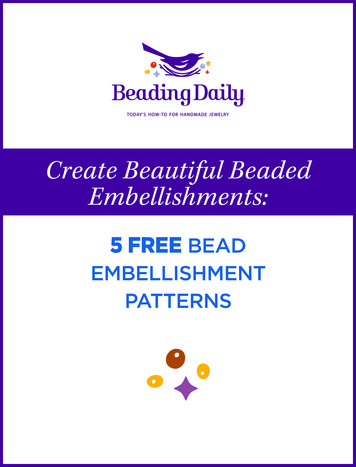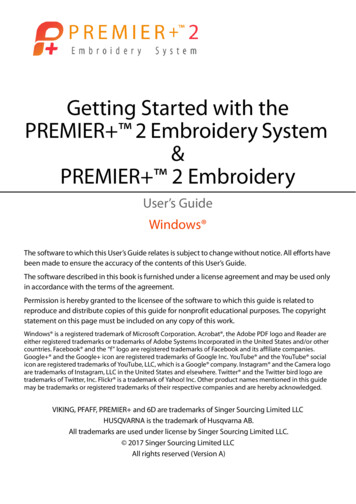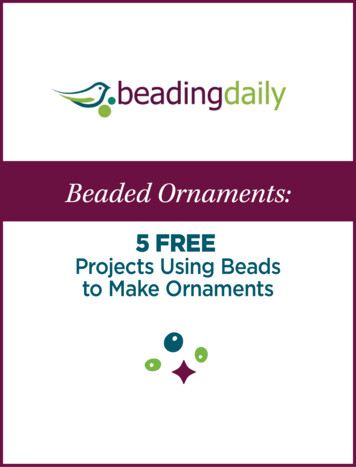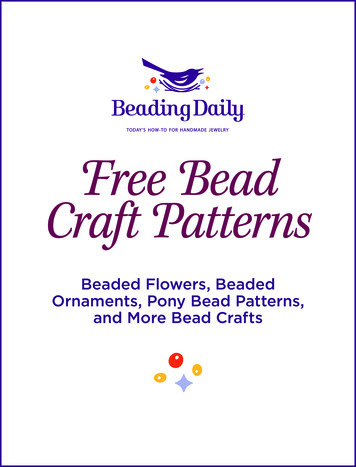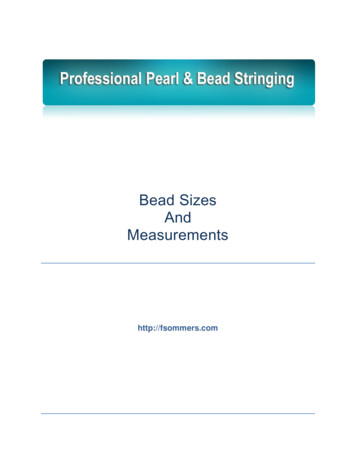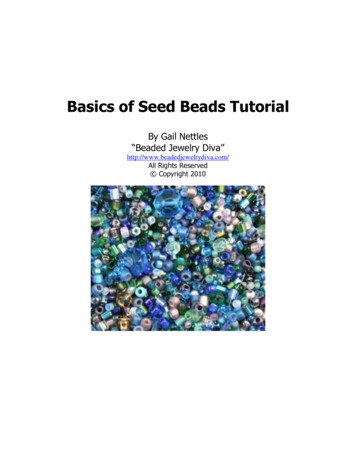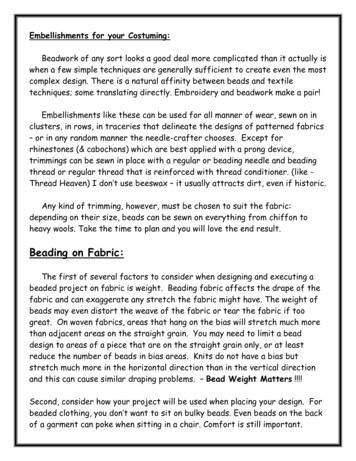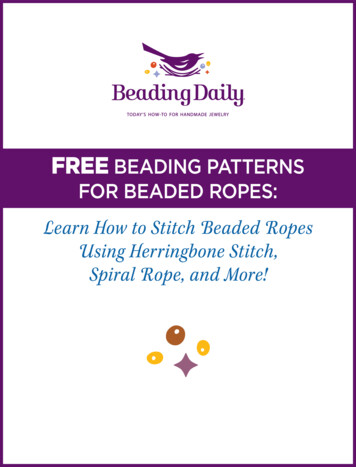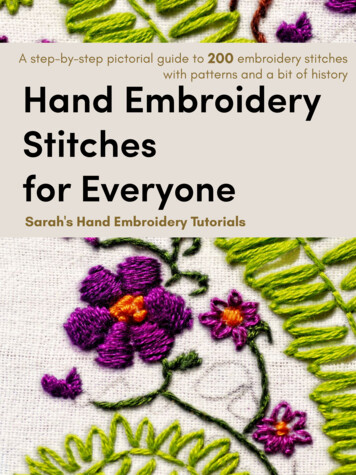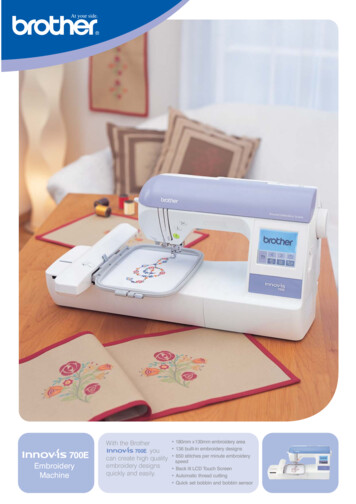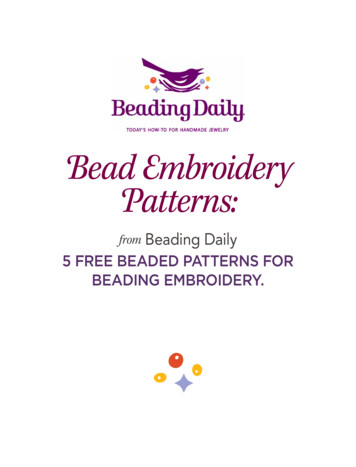
Transcription
Bead EmbroideryPatterns:Beading Daily5 Free Beaded Patterns forBeading Embroidery.from
Bead Embroidery Patternskachina Goddess pinilluminated letterscaptive heart pouchby Jody Johnston-Duran p. 2by Dustin Wedekind p. 4by marlene Blessing p. 6Star-Studded BraceletDay in the Suntechniquesby Judy Brownell p. 8by kelli Burns p. 10p. 13Contentsii
Bead Embroidery PatternsIf you’ve ever seen the awesome and inspiring bead embroidery of artists like Sherry Serafini, you might have beeninspired to try your hand at this particular beading technique.Unlike other types of off-loom beadweaving, bead embroideryis the stitching of seed beads to a fabric or felt-like backing.While the basic stitches used in bead embroidery are relatively simple, the results can be spectacular. Bead embroideryallows you to “paint” with your beads on a fabric “canvas” fora look that you just can’t get with other beadweaving techniques. You can also easily incorporate found objects, gemstone and handmade cabochons, and other unique jewelrymaking components into your bead-embroidery projects.While bead embroidery can be used to make spectacularbeaded jewelry, it can also be used to add a decorative touchto all sorts of things such as purses and handbags, clothing,and even shoes! Bead embroidery is instantly recognizable inNative American beadwork, and some of the most breathtaking fashions seen on the runway in the twenty-first centuryhave also been decorated with beaded embroidery.Because bead embroidery is such a versatile beading technique, we chose five of our favorite bead-embroidery patternsthat cover a wide range of styles and techniques. To start,make the Kachina Goddess Pin by Jody Johnston-Duranand learn how to incorporate cabochons and bugle beads intoyour bead-embroidery projects. Dustin Wedekind’s beautifulIlluminated Letters will help you master beaded backstitchwhile you create a personal bead-embroidered pin inspiredby the richly illustrated manuscripts from the Renaissance.You can also use beaded embroidery to embellish a keepsake pouch by creating Marlene Blessing’s Captive HeartPouch. Judy Brownell’s Star-Studded Bracelet shows thatsometimes less can be more in bead embroidery – especiallywhen it involves some sparkling crystal sew-on beads. Finally,practice all your new bead-embroidery skills when you createKelli Burns’s Day in the Sun bead-embroidered cuff with itsvibrant garden of Lucite flowers and brightly colored seedbeads.Bead embroidery is a wonderfully versatile beading technique. Whether you like your bead-embroidery patterns to befun and fast or more complex and textured, bead embroideryis the perfect way to blend seed beads and other jewelry-making components into gorgeous and unique beaded jewelryand accessories. Enjoy these free beading patterns for beadembroidery and see where they lead you on your personalbeading journey!Bead Happy,Jennifer VanBenschoten, Beading Daily editorBead Embroidery Patterns from Beading Dailyeditor, beadingdaily JENNIFER VANBENSCHOTENdesigner CONNIE POOLE / photography JOE COCA, ANN SWANSONProjects and information are for inspiration and personal use only. BeadingDaily, Beadwork, and Stringing do not recommend, approve, or endorse any of the advertisers, products, services, orviews advertised in this publication. Nor do BeadingDaily, Beadwork, or Stringing evaluate the advertisers’ claims in any way. You should, therefore, use your own judgment in evaluating theadvertisers, products, services, and views advertised in BeadingDaily, Beadwork, and Stringing.1
kachina goddessJody K. Johnston-DuranUse bead embroidery to turn a cabochoninto an elegant inspired piece of art.More wonderful beadwork projects are available at shop.beadingdaily.com/jewelryprojects 2011 Interweave Press LLC. Not to be reprinted. All rights reserved.page 2
Spend some time with your beads. I know this sounds simple, becauseyou probably do this a great deal anyway. But it is really important toaudition your stones with your different beads. I begin by laying out possible designs on the table and playing with the composition. When I seea certain cabochon, I often envision the finished piece in my mind and Ican jump right to the next step. Sometimes I have an inspiration but nota specific vision of a finished piece, so tracing the cabochon on paperand sketching designs with a pencil, or draping strands of beads aroundthe cabochon, helps me get going.MaterialsSize 11 seed beads in twoor more colors3" stone cabochonStone disk or donut beadSize 3–5 bugle beadsAssorted 3mm semiprecious stonebeads and freshwater pearls5" x 8" piece of UltrasuedeSize B Nymo beading threadPlastic milk jugBuckskinPinback or lobster claw claspNotionsSize 12 beading needlesSharp pointed embroidery scissorsHeavy-duty scissorsE6000 jewelry adhesiveBeeswaxFine point permanent markerStep 1: Glue your cabochon to theUltrasuede. Allow to dry for 24 hours.Step 2: Double and wax a yard ofthread to be 18" in length. Begin thefirst round of backstitch close to theedge of the stone using 4 seed beads ata time. Make sure your tension is evenand not too tight. Continue backstitching around the stone.Step 3: Stitch another round of seedbeads next to the first. Every once ina while stop and take a look at yourpiece from a distance to see if thebeadwork looks finished. The beadsshould accentuate the beauty of thestone, not compete with it.Step 4: Stitch seed beads inside thestone disk and do one round of backstitching around the disk. Stitch buglebeads around the disk in a fanlikecomposition. Stitch seed beads in anarc between each bugle. Again, takea step back and look at the piece froma distance. Add more bugles or fillthe entire headpiece with beads.Step 5: When you have finished thestitching, use the scissors to trim theUltrasuede along the edge of the lastround of beads. It is important tokeep your scissors perpendicularto the bead stitching to preventcutting thread.Step 6: Make a simple row of fringe atthe bottom and sides of the headdress.Begin at the left side bottom, workingtoward the right. Experiment withthe length of the fringe to determinewhat’s best for your design. The lengthof the fringe will affect your composition; it will change if you want towear it as a pin or a necklace. To makethe fringe shown here, string 4 seedbeads, 1 bugle, 14 seed beads, and astone drop or 5 seed beads. Pass backthrough the 14 seed beads, 1 bugle,and 4 seed beads, then back into theUltrasuede. Take one stitch on eachside of the fringe to secure it. Repeatuntil there are about 14 to 16 danglesof fringe.Step 7: Trace the outline of the pieceonto the plastic. Cut it a bit smallerthan the outline. Glue the plastic tothe back of the piece. Trace the outlineagain onto the rough side of a pieceof buckskin. Be careful as you trimbecause buckskin tends to stretch.Glue the buckskin to the back and/or stitch around the edges to seam itwith the Ultrasuede. Glue a pinback tothe buckskin to finish, or follow Step 8for a necklace.Step 8: To make a necklace, use a 24"doubled thread to string one side ofthe lobster clasp and tie a knot, leaving a 3" tail. String 8" of seed beadsand a few accent beads. Pass throughthe Ultrasuede and leather at the topof the pendant. Make two more stitches through the layers and pass backthrough the accent beads. *String 10seed beads and pass through a corresponding bead on the first strand.Pass through the last bead strung.Repeat from * until you reach theclasp. Pass through the clasp and backthrough a few beads. Tie a knot, passthrough a few more beads, and trimclose to work. Thread the tail threadsand pass them back through the firststrand and trim close to work. Dabsome glue on the knot at the clasp.Repeat for the other side of the clasp.Sign and date the piece on the backwith the marker.More wonderful beadwork projects are available at shop.beadingdaily.com/jewelryprojects 2011 Interweave Press LLC. Not to be reprinted. All rights reserved.page 3
illuminated lettersD u s t i n W edek i n dTip: This is a great projectfor using up all those littlebeads you have left overfrom other projects.These pins were inspired by medieval manuscripts created by monks who drew fantasticflora, fauna, and other patterns around letters in their books. Follow the simple guidelineshere to embroider a rich-looking letter brooch, and you’ll soon be on your way to beadinga whole alphabet—without taking any vows!More wonderful beadwork projects are available at shop.beadingdaily.com/jewelryprojects 2011 Interweave Press LLC. Not to be reprinted. All rights reserved.page 4
Materials3–5mm beads: freshwater pearls, firepolished, semiprecious stone, or size8 seed beadsSize 11 seed beads in dark, light,and contrasting colorsAccent beads, buttons, or charmsPin backTwo 4” squares of Eazy FeltSize D beading threadThread Heaven or beeswaxNotionsSize 10 or 12 beading needleScissorsColored pencilTechniquesSingle stitch and backstitch embroideryFinished Size: 3” x 3”Figure 1Step 1: Draw a simple letter on a pieceof felt at least 3 4" from the edges. Asyou form the letter with a single line,exaggerate any open spaces withinthe letter (Figure 1).Step 2: Knot the end of a 6' piece ofthread and pass through the back ofthe felt along the penciled line. Usesingle stitch embroidery to follow theline with 5mm and/or size 8 seedbeads.Step 3: Backstitch a row of size 11 seed beads in the contrasting colorall around the letter. Stitch close tothe beads, but keep the line straight(Figure 2).Step 4: Backstitch a row of lightcolored size 11 s around the letter, followed by a row of dark-colored beadsand another row of contrasting beads.Step 5: Sew accent beads to completelycover the negative spaces of the letter.Figure 2Pass through larger beads a few timesto thoroughly secure them.Step 6: Trim the felt to 1 8" around thebeads, being careful not to cut yourstitches. Cut another piece of felt tothe same size. With a new piece ofthread, sew the pin back to the backof the second piece of felt. Pass theneedle through the felt to the edgeand stack the two pieces.Step 7: Exiting the back of the brooch,about 1 8" from the edge, string 3 darkseed beads. Pass through the top ofthe brooch, right next to the outsiderow of beads, and exit the back nearthe edge (Figure 3). Repeat all around,alternating 2 stitches using lightbeads with 1 stitch using dark beads.Finish the thread by trying a knot onthe back, then passing through the feltand trimming close to the work.Resource Eazy Felt: Any large craft store.Figure 3Ad space (1/3 p)More wonderful beadwork projects are available at shop.beadingdaily.com/jewelryprojects 2011 Interweave Press LLC. Not to be reprinted. All rights reserved.page 5
captive heart pouchMarlene Blessing“ When I give a handmade beaded bracelet or necklace tosomeone dear, the gift becomes more special if it’s deliveredin an embellished pouch. The beautiful Allium ribbon fromtextile designer Laura Foster Nicholson tied everythingtogether from the front flap to the back, and the Captive Heartpendant from Green Girl Studios is a beautiful solution forclosing the pouch.”More wonderful beadwork projects are available at shop.beadingdaily.com/jewelryprojects 2011 Interweave Press LLC. Not to be reprinted. All rights reserved.page 6
MaterialsSize 11º seed beads in assorted colors (amber/brick matte, black matteopaque, dark olive matte metallic iris,raspberry luster, amethyst/Montanamatte, cream matte opaque, paprikaopaque, olive/gold matte metallic, red/purple matte metallic)1 pewter 30x12mm pendant1 pewter 20mm coinCream Nymo size D beading threadBlack size 8 black pearl-cotton embroidery threadBlack sewing thread8” square of wine red felt5 x 73 4" of olive green felt8 x 21 2" of jacquard taffeta ribbonToolsBeading needleEmbroidery needleSewing machineScissorsStraight pinsTailor’s chalktechniquessewingbead embroideryFinished size: 51 2 x 81 2"step 1: Flap ribbon. Mark the sideedges of the red felt 21 2" from the top.Draw a line from each mark to thecenter top of the felt. Cut along thelines, forming the point of the flap.Center the ribbon down the back sothat it extends 3 8" beyond the tip of theflap. Miter the ribbon by folding theraw edge under, along each cut edgeof the flap; pin or baste the ribbon inplace. Use black thread to sew theedges of the ribbon with a 1 8" seamallowance all around, tucking theother end of the ribbon under so thatits folded edge is 5 8" from the bottomedge of the felt (Figure 1).step 2: Bead embroidery. Draw 3graduating spirals from left to righton the lower two-thirds of the greenfelt, making sure that none is closerthan 3 4" to the bottom or side edges.Work rows of single stitch to beadembroider the spirals: for the largespiral, stitch 3 dense rows (amber/brick, dark olive, olive/gold), then 1open row along the inner (black), and1 open row along the outer (cream)edges of the spiral; for the midsizedspiral, stitch 2 dense rows (raspberry,paprika), then 1 open row along theinner (olive/gold), and 1 open rowalong the outer (amethyst/Montana)edges; and for the smallest spiral,stitch 2 dense rows (black, red-purple),then 1 open row (amber/brick) along 8"321 2" 8"5Figure 1the outer edge of the spiral.step 3: Pocket. With the ribbon sideof the red felt facedown, position thegreen felt on top so it is 3 8" from thebottom and sides of the red piece.Baste or pin in place. Machine-sewon the zigzag setting around the sidesand bottom, about 1 4" from the edgesof the green piece.step 4: Charms. Use pearl cottonto attach the coin in the upper leftcorner of the green felt. To attachthe pendant, pass through from theunderside of the ribbon, 3 4" from thetip of the flap; string the pendant andpass back through the flap, leavinga 1 4" loop. Pass through the flap andpendant again, and reinforce the loopby covering it with half hitch knots;secure the thread on the underside ofthe flap and trim.Resources Check your local bead shopor contact: Seed beads: Beyond Beadery,(303) 258-9389, www.beyondbeadery.com. Pewter pendant and coin: Green GirlStudios, (828) 298-2263, www.greengirlstudios.com. Ribbon: LFN Textiles, (812) 6823733, www.lfntextiles.com. Felt and DMCpearl cotton: Jo-Ann, www.joann.com.More wonderful beadwork projects are available at shop.beadingdaily.com/jewelryprojects 2011 Interweave Press LLC. Not to be reprinted. All rights reserved.page 7
star-studded braceletJudy BrownellAs soon as Judy saw Lochrosen crystals, she became obsessed with trying to find more ofthem. Here she shows off their beauty by stitching them to a piece of teal Ultrasuede, whichwith a crystal button and loop added becomes a glittering bracelet.More wonderful beadwork projects are available at shop.beadingdaily.com/jewelryprojects 2011 Interweave Press LLC. Not to be reprinted. All rights reserved.page 8
Materials5 g silver-lined clear size 15 Japaneseseed beads5 g metallic silver size 11 Japanese seedbeads116 crystal tabac 3mm Lochrosen crystals50 clear 3mm Lochrosen crystals40 tanzanite 4mm Lochrosen crystals30 olivine 4mm Lochrosen crystals3 crystal sage 6mm crystal squares1 crystal satin 12mm squarecrystal button2 dark teal 8 x 11 2" pieces of lightweightUltrasuedeBraided beading threadE-6000 adhesiveToolsSize 10 beading needleScissorstechniquebead embroideryFinished size: 73 4 x 7 8”edfcbaFigure 1Step 1: Center square. Secure 36" ofthread in the back of one piece of fabric, passing through to the front at thecenter. String 1 crystal square and 1size 15 ; pass back through the squareand fabric. Pull snug and pass throughto the front next to the square. String1 clear crystal and 1 size 15 ; pass backthrough the crystal and fabric, pullsnug, and pass through to the frontnext to the crystal. Continue stitching,surrounding the square with the clearcrystals (Figure 1a).Step 2: Mid square. Pass through tothe front at the center of one side ofthe square. Stitch a row of 7 tanzanitecrystals along the midline toward oneend of the fabric (Figure 1b). Keep thestitches close so that the crystals arenearly overlapping. At the end of therow, work another square surroundedwith clear crystals (Figure 1c).Step 3: Triangle. Beginning on theopposite side of the end square, stitcha row of 8 tanzanite crystals, or 23 4"from the center square (Figure 1d).Stitch 10 clear crystals to form a triangle (Figure 1e).Step 4: Border. Work back towardthe center square, stitching olivinecrystals along one side of the row oftanzanite crystals (Figure 1f). RepeatSteps 2 and 3 for the other side of thebracelet. Continue stitching olivinecrystals along each side of the tanzanite rows so that you have three rowseven with the surrounded squares.Work a border of 3mm tabac crystalsaround the entire design, includingthe triangles at each end. Secure thethread in the back of the fabric behindthe crystals.Step 5: Backing. Spread a thin layer ofadhesive on the back of the work, upto 1 4" from the edges. Press the piecestogether and allow to dry overnight.Trim both pieces all around, about 1 16"from the crystals.Step 6: Edging. Secure 4' of threadbetween the layers at one of the endpoints and pass through to the frontalong the edge. String 1 size 11 andFigure 2Figure 3pass up through both layers at thebase of the thread and through thebead again. String 1 size 11 and passup through both layers just below theprevious bead; pull snug and passthrough the bead just strung (Figure2). Repeat all along the edge to theother end and work 2 edge beads atthe point.Step 7: Loop. String 26 size 11 s (orenough to accommodate the crystalbutton) and pass through the last2 edge beads to form a loop. Passthrough the first 7 beads just strung.*String 1 size 11 , 1 tanzanite, 1 tabac,and 1 size 15 ; pass back through bothcrystals and the size 11 . Pull snug andpass through the next 13 beads of theloop. Repeat once from * (Figure 3).Pass through the loop again to reinforce, then continue working the edgetoward the start.Step 8: Button. Pass through the firstedge bead, string 2 size 11 s and onehole of the button. Pass back throughthe second hole, string 2 size 11 s,and pass through the last edge bead.Weave through the beads and buttonagain to reinforce, then secure thethread and trim close.More wonderful beadwork projects are available at shop.beadingdaily.com/jewelryprojects 2011 Interweave Press LLC. Not to be reprinted. All rights reserved.page 9
day in the sunCreate this blooming cuff with a garden of Lucitecomponents. It’s an easy backstitch-embroideryproject that turns into a wonderful threedimensional work of art.Artist’s Tips Since only a small amount of eachseed-bead color is needed, this agreat project for using up leftoverbeads. Vary sizes, colors, and shapesof the Lucite leaves for a natural,authentic-looking 3-D flower. If needed, use chain-nose pliersto help pull your needle throughthe Ultrasude.More wonderful beadwork projects are available at shop.beadingdaily.com/jewelryprojects 2011 Interweave Press LLC. Not to be reprinted. All rights reserved.page 10Kelli Burns
Materials2 g each size 15 seed beads in Ceylonrobin’s egg blue, sky blue, silver-linedroot beer, silver-lined olive, denim blue,and silver-lined tangerine4–6 g each size 11 seed beads in transparFigure 1ent robin’s egg blue, silver-lined mattechartreuse, and silver-lined tangerine3–4 g each size 8 seed beads in Ceylonrobin’s egg blue and silver-lined matteStep 1: Foundation. Measure thechartreuse1 g silver-lined aqua size 8 hex seed beads length and width of the cuff. Draw thedimensions on the beading founda10 frosted chartreuse AB 12mm twistedtion. Leaving an edge of at least ¼”bugle beads25 frosted aqua AB 3 4mm glass dropsaround all sides, lightly draw vines10 jonquil AB 3 4mm glass dropsand leaves onto the foundation (Fig.46 pale yellow 6 2mm Lucite flowers1). Note: The lines you draw may be2 light yellow 10 3mm Lucite flowersvisible through the beads, so keep2 celery 10 18mm Lucite leavesthem light. Find the exact center2 olive green 10 18mm Lucite leavesof the drawing and lightly sketch a3 pale yellow 15mm Lucite leaves19mm circle. You’ll keep this circle9 gold 15mm Lucite leavesfree of beads so you can add the focal6 caramel 15mm Lucite leavesflower later.1 celery 12 28mm Lucite leaf1 olive 17 30mm Lucite leafStep 1: Vines. Tie a knot at one end of1 smoky topaz 12mm crystal rivoli3’ of thread. Pass up through the bead1 metal 40mm wide tapered cuff blanking foundation from back to front,4 6” piece of beading foundationexiting from one of the vine lines.4 6” piece of navy blue UltrasuedeUse chartreuse size 11 s to backstitchSize B or D nylon beading thread in colorthe vine lines, adding in bugle beadsto match beadsoccasionally to vary the line. Once theClear jeweler’s adhesivevines are complete, backstitch moreToolsScissorsSize 10 or 12 English beading needlesToothpicksPenFigure 2lines along the vines, using variousseed-bead sizes, colors, and clustersof drops. Create added texture anddepth by setting lines of smallerbeads against lines of larger ones.Fill in the entire foundation exceptthe 19mm circle.optiontechniquesbead embroideryfringebrick stitchpicotGive your focal crystal greaterpresence by bezeling it in peyotestitch and surrounding it withlow-profile pointed leaves. Alsoconsider bead-embroideringonly a minimal amount of beadsdirectly on colored Ultrasuede(in place of the beading foundation)—the texture of the Ultrasuede adds richness tothe design.Finished size: 6¾” (inside measurement)More wonderful beadwork projects are available at shop.beadingdaily.com/jewelryprojects 2011 Interweave Press LLC. Not to be reprinted. All rights reserved.page 11
Figure 3Figure 4Step 1: Focal flower. Lay the hole of1 caramel 15mm leaf just inside the19mm circle. Securely stitch the leaf tothe beading foundation three times.Repeat to add a total of 6 gold leaves,1 celery 12 28mm leaf, and 1 olive17 30mm leaf around the circle (Fig.2). Note: The outside edges of a few ofthe leaves may overlap slightly onceworn, but it is best to arrange them inthis round so only the outside edgestouch. Sew a second round of 5 goldleaves inside the round just added,placing each new leaf between theleaves from the first round (Fig. 3).Sew a third round of 4 gold leaves,then a fourth round of 3 pale yellowleaves, leaving just enough space inthe center for the rivoli (Fig. 4). Securethe thread and trim. Use a toothpickto dab the back of the rivoli with glueand press it to the center of the flower.Let dry overnight.Step 1: Fringe. Start 3’ of new threadon the beading foundation that exitsup through the beadwork near avine. String one 6 2mm or 10 3mmflower and 1 root beer size 15º; passback through the flower and into abackstitched vine bead near the placeyou last exited. Pass through severalvine beads and repeat to add a totalof 12 flower fringes along the vines,arranging them in a random patternon both sides of the focal and usingboth 10 3mm flowers so only 6 2mmflowers remain unused. For 4 of thefringes, string a 10 18mm green leafbefore you string the flower. Securethe thread and trim.Step 1: Assembly. Lay the beadworkagainst the front of the cuff to checkfor fit. Add beads, if necessary, tocover any exposed foundation thatshows after the beadwork is bent overthe cuff. Use a toothpick to apply alayer of glue to the back of the beadwork. Cover the front of the cuff withthe beadwork and allow to dry. Repeatthis step to add the Ultrasuede to theback of the cuff. Once the glue is dry,trim the Ultrasuede and beadingfoundation edges 1 16" from thecuff edge.Step 1: Edging. Tie a knot at the end of3' of thread. Sew through the edge ofthe beading foundation from back tofront so the knot is hidden betweenthe fabric layers. Work brick-stitchedging, then picot and fringe edgingto complete the cuff:Brick-stitch edging: String2 chartreuse size 11 s; sew downthrough both layers of fabric and passback up through the last bead strung.String 1 chartreuse size 11 and sewthrough both layers of fabric nextto where you placed the last bead,then pass back through the bead juststrung; repeat around the edge of thecuff to connect the fabric layers (Fig.5). Pass down through the first beadadded and up through the last oneadded to complete the edging (Fig. 6).Picot-and-fringe edging:Weave through the brick-stitchedbeads to exit up through a size 11 about 10 beads from one corner ofthe cuff. String 3 olive size 15 s, passdown through the adjacent size 11 on the edging, and pass up throughthe following edge bead. String a6 2mm flower and 1 root beer size 15 ;pass back through the flower, downthrough the last size 11 exited, skipan edge size 11 , and pass up throughthe following size 11 . Repeat to alternate picots and flowers along the topof the cuff edge, adding a total of 18flowers (Fig. 7). Work picots along theends of the cuff. Repeat this step toadd 18 flowers along the bottom of thecuff edge. Secure the thread and trim.Figure 5Resources Check your local bead shopor contact: G-S Hypo jeweler’s cement,Swarovski crystal rivoli, Lacy’s Stiff Stuffbeading foundation, Nymo nylon beadingthread, and all other beads and findings:The Hole Bead Shoppe, (918) 338-2444,www.theholebeadshop.com.Figure 6More wonderful beadwork projects are available at shop.beadingdaily.com/jewelryprojects 2011 Interweave Press LLC. Not to be reprinted. All rights reserved.page 12
techniquesStringingStringing is a technique in which youuse beading wire, needle and thread,or other material to gather beads intoa strand.Brick StitchBegin by creating a foundation row in ladder stitch. String 2 beads and passunder the closest exposed loop of thefound ation row and back through thesecond bead. String 1 bead and passunder the next exposed loop and backthrough the bead just strung; repeat.Ending and Adding ThreadTo end your thread, stop beading whenyou have at least 6" of working thread.Always end after completing a step upso that it won’t matter where you beginthe new round. Tie off the thread bypassing back through the beadwork ata diagonal and tying half-hitch knotsafter each chip or shared bead. Passthrough 3 Delicas and trim and meltthe end.To decrease within a row, string 1 beadand skip a loop of thread on the previous row, passing under the second loopand back through the bead.To begin a new doubled thread, tie aknot in the end and melt or glue it toseal it. Begin stitching at least 4 stitchesback in the work, knotting after eachshared bead. Exit a middle point beadto begin the next round.To increase within a row, work twostitches in the same loop on the previous row.FringeExit from your foundation row of beadsor fabric. String a length of beads plus1 bead. Skipping the last bead, passback through all the beads just strungto create a fringe leg. Pass back intothe foundation row or fabric.Tension BeadA tension bead (or stopper bead) holdsyour work in place. To make one, stringa bead larger than those you areworking with, then pass through thebead one or more times, making surenot to split your thread. The bead willbe able to slide along, but will stillprovide tension to workagainst when you’rebeading the first tworows.Bead EmbroideryFor single stitch embroidery, begin bypassing the needle through the fabric,from wrong side to right side, at theplace where the first bead is to go.String a bead and pass the needle backthrough the fabric right next to thebead. Bring the needle back throughthe fabric where the next bead is togo, thread one bead and go back downthrough the fabric. Continue.Use bugle beads between 2 seed beadsto protect the thread from the sharpedges on bugle beads and single-stitchas one bead.For backstitch embroidery, begin bypassing through the fabric, from wrongside to right side. String 4 beads. Lay thebeads against the fabric and pass downthrough it just past the fourth bead.Pass up through the fabric betweenthe second and third beads and passthrough the last two beads just strung.String 4 beads and repeat.More wonderful beadwork projects are available at shop.beadingdaily.com/jewelryprojects 2011 Interweave Press LLC. Not to be reprinted. All rights reserved.page 13
practice all your new bead-embroidery skills when you create Kelli Burns's Day in the Sun bead-embroidered cuff with its vibrant garden of Lucite flowers and brightly colored seed beads. Bead embroidery is a wonderfully versatile beading tech-nique. Whether you like your bead-embroidery patterns to be fun and fast or more complex and textured .
